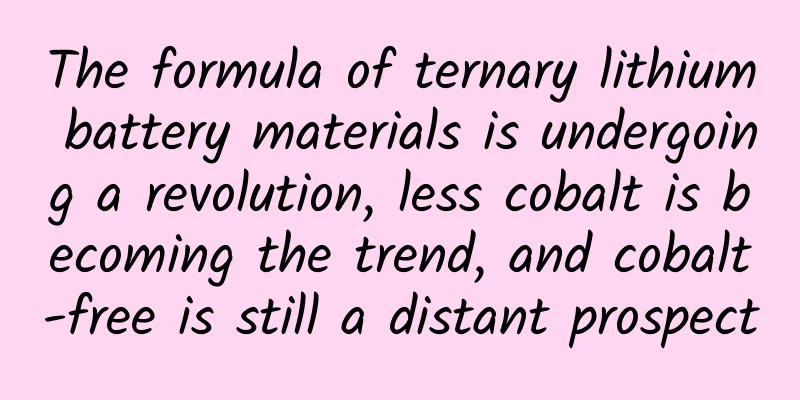The formula of ternary lithium battery materials is undergoing a revolution, less cobalt is becoming the trend, and cobalt-free is still a distant prospect

|
Recently, Japanese battery supplier Panasonic announced that it will develop cobalt-free automotive-grade batteries. As the electric vehicle market continues to be hot, its core component, power batteries, are also "rising with the tide", and the demand for the current mainstream battery, ternary lithium batteries, continues to grow. As one of the positive electrode materials for ternary lithium batteries, cobalt has become a strategic rare metal resource due to its scarcity. 66% of the world's cobalt production comes from the politically unstable Congo (Kinshasa), resulting in limited reserves and rising prices, which has become a constraint on the development of new energy vehicles. Therefore, automobile manufacturers and battery companies are developing to reduce the proportion of cobalt in the formula of ternary lithium battery materials. Some companies have even begun to develop cobalt-free batteries, but it seems that the cobalt-free solution is still difficult to achieve at present. Cobalt prices rise as supply exceeds demand Recently, Bloomberg New Energy Finance (BNEF) released a report predicting that the cobalt shortage may come earlier than expected. The shortage of this most expensive material for power batteries will have a greater impact on the electric vehicle industry in the next 5 to 10 years. Data shows that the cobalt output of the Democratic Republic of the Congo accounts for 2/3 of the world's cobalt mines, and new resource sources are urgently needed. In addition, many oligopolistic mining companies are hoarding cobalt in large quantities, making cobalt even more difficult to obtain. An analyst from BNEF said: "Judging from the current situation, it will take a long time to find new mineral resources. If we only rely on the cobalt resources in the Democratic Republic of the Congo, there is a high probability that there will be a cobalt supply crisis by 2020." BMW Group said that automakers that are vigorously deploying electric vehicles are already aware of the supply crisis. It is worth mentioning that the world's largest new energy vehicle market, China, is growing faster than expected, and cobalt will be in short supply in a short period of time. Analysts pointed out that if the supply of cobalt cannot be steadily increased, the price of cobalt will rise sharply, which will have a serious impact on the development of the electric vehicle market. Data shows that since the beginning of 2016, the price of cobalt on the London Stock Exchange has increased by 270%, and hit a record high in March this year. Pete Dineen, director of the Electric Vehicle Metal Resources Group, said in an email that regardless of whether the political situation in the Democratic Republic of the Congo will affect the export of cobalt, the current high price has fully reflected the shortage of cobalt. Currently, Panasonic has been trying to ensure its stable supply in the cobalt market. Industry insiders predict that Panasonic's cobalt consumption will reach nearly 8,000 tons by 2018. In addition, BMW, Volkswagen, Samsung SDI, LG Chem and other companies are also seeking stable sources of supply. Previously, Volkswagen and BMW hoped to sign long-term contracts with cobalt suppliers, but the progress was not smooth. Xu Aidong, Secretary General of the Cobalt Branch of the China Nonferrous Metals Industry Association, specifically talked about the topic of end users locking resources with upstream suppliers at the China (Qinghai) Lithium Industry and Power Battery International Summit Forum held recently. She said: "In order to lock in prices, many companies have to sign 10-year contracts with upstream suppliers. This behavior is not very rational. Although the cobalt market is very hot now, no one can guarantee that the current price is low. On the one hand, the price cannot be locked; on the other hand, many cobalt mining industries have joined the 'responsible supply chain' system, hoping to achieve sustainable mineral procurement in the cobalt industry." High nickel and low cobalt are the general trend Faced with increasing costs, global battery suppliers are trying to reduce the content of cobalt in ternary batteries. They have changed the formula ratio of battery positive electrode materials, changing the ratio of nickel, cobalt, manganese or nickel, cobalt, and aluminum in ternary batteries from 6:2:2 to 8:1:1. Many Chinese power battery companies are also planning high-nickel ternary batteries. High nickel and low cobalt are, on the one hand, to increase energy density, and on the other hand, to reduce costs. Car companies are also working hard to develop advanced technologies to further reduce the content of cobalt in batteries. Currently, BYD plans to adjust the ratio of nickel, cobalt and manganese to 8:1:1 by the end of this year, and BMW is expected to adopt this formula in 2021. It is expected that by 2020, this type of low-cobalt battery will account for 7% of the total number of electric vehicle batteries, and by 2030, this proportion will increase to 57%, thereby reducing the impact of battery raw materials on the total price of batteries. Obviously, Panasonic is more radical and hopes to reduce the content of cobalt in ternary batteries to zero. Ken Tamura, head of Panasonic's automotive battery department, said: "We have greatly reduced the content of cobalt in batteries. The proportion of cobalt in ternary batteries has dropped to 3%. Now our goal is to achieve cobalt-free. This technology is already under development." As the exclusive battery supplier for Tesla Model 3, Panasonic currently produces batteries in its super factory in Nevada, USA. Yoshiro Ito, head of Panasonic's automotive business, said that in addition to minimizing the use of cobalt in battery technology, Panasonic is also actively negotiating with cobalt suppliers, hoping to sign a long-term and stable supply contract, "so that the company can avoid risks caused by soaring raw material prices." In early May, Tesla announced that the battery installed in its Model 3 has greatly reduced the cobalt content, while increasing the nickel content, thus achieving the highest energy density ever and achieving super heat resistance. Recently, Tesla CEO Musk said on social media that the cobalt content in the battery of Tesla Model 3 has been reduced to less than 3%. They will continue to improve technology and strive to completely abandon cobalt in the next generation of batteries to change the reputation of "bloody batteries". Cobalt-free is unlikely in the short term In addition to reducing the proportion of cobalt in batteries, recycling cobalt is also a solution. According to a report by BNEF, the current recycling rate of cobalt is only 25% to 50%. If the cobalt in all passenger car batteries can be recycled, the total amount of recycled cobalt is expected to reach 100,000 metric tons per year by 2030. Currently, companies including Samsung SDI and BMW are actively exploring the recycling of cobalt from mobile phone and car batteries. However, whether it is reducing the cobalt content in batteries or recycling cobalt, it can only alleviate the temporary predicament and cannot really solve the supply problem. So are cobalt-free batteries really feasible? As one of the important raw materials for lithium batteries, cobalt can significantly improve the energy density of lithium batteries. In order to replace cobalt, battery manufacturers often increase the use of nickel to increase the energy density of the battery. However, the increase in the use of nickel will lead to a decrease in the structural stability of the corresponding electrode materials, which in turn affects the battery cycle life and safety. Some industry insiders believe that at present, car companies and battery suppliers have only reduced the proportion of cobalt in ternary battery materials, but cobalt cannot be replaced at present. "From the perspective of lithium battery technology, when the ratio of nickel, cobalt and manganese is 8:1:1, the battery energy density reaches 300 watt-hours/kilogram, which can clearly be seen as a 'ceiling', and it may not be broken through in the next 10 years." Sun Xiaodong, vice president of Ningbo Shanshan Co., Ltd., said at the International Summit Forum on Lithium Industry and Power Batteries. Many industry insiders also said that although many battery suppliers are reducing the use of cobalt, most manufacturers have not realized the application of the 8:1:1 technical route in mass production. As for the time for cobalt-free batteries to be put on the market, it may be even longer. Xu Aidong also said: "In fact, the current output of 8:1:1 ternary batteries is less than 10% of the total, because battery companies must also consider safety issues while reducing costs." She believes that from a strategic perspective, high nickel and low cobalt is definitely the development direction, but cobalt cannot be replaced in the short term. On the one hand, the change in formula ratio brings challenges to battery packaging, and currently lithium batteries are still mainly cylindrical packaging, and soft pack and square technology are not yet mature; on the other hand, electric vehicles must reduce costs and achieve development, but safety and quality must be guaranteed as a prerequisite. "We cannot rush into it blindly in pursuit of cost reduction," she said. ■ Cobalt prices are expected to stabilize in the medium and long term The good news is that cobalt prices will not continue to rise. The latest data shows that since June 1, domestic cobalt prices have continued to fall, and the price of cobalt on June 26 was 542,600 yuan/ton. After more than a year of crazy growth, the price of cobalt has finally come to a "sudden brake". Xu Aidong said that the development of new energy vehicles and power battery industries has obviously driven upstream materials. Since last year, the price of cobalt has increased significantly, which has attracted great attention from the market. But when the price rises to a certain level, the adjustment of the supply chain will make it stabilize. Wang Zidong, director of the Power Battery Laboratory of the China North Vehicle Research Institute, said in an interview with a reporter from China Automotive News that cobalt prices have begun to fall, indicating that cobalt does not have such a big impact on automotive batteries, and that ternary batteries are not a panacea. He believes that lithium iron phosphate batteries also have good development prospects. Luo Huanta, president of the Gaogong Industry Research Institute, holds the same view. He believes: "From the production in the first quarter, the growth rate of domestic ternary batteries reached 63%. However, after the price of positive electrode materials, especially cobalt, has risen, many companies are now thinking about or trying to slow down the change in the proportion of ternary materials, or take the lithium iron phosphate route. Some companies have already begun to try this." Xu Aidong finally pointed out that with the development of ternary lithium battery materials, the consumption intensity of cobalt will decline, but the total consumption will still increase. Compared with lithium and nickel, the consumption growth rate of cobalt will slow down. At the same time, the trend of high nickelization caused by rising cobalt prices and tightening supply chains will also have an impact on the consumption prospects and investment of cobalt. As long as the price of cobalt returns to a more moderate price, it will still stimulate its consumption growth. In general, she believes that with the popularization of electric vehicles, battery technology will also undergo major changes, and the comprehensive role of various aspects can maintain the stable development of the battery industry. As a winner of Toutiao's Qingyun Plan and Baijiahao's Bai+ Plan, the 2019 Baidu Digital Author of the Year, the Baijiahao's Most Popular Author in the Technology Field, the 2019 Sogou Technology and Culture Author, and the 2021 Baijiahao Quarterly Influential Creator, he has won many awards, including the 2013 Sohu Best Industry Media Person, the 2015 China New Media Entrepreneurship Competition Beijing Third Place, the 2015 Guangmang Experience Award, the 2015 China New Media Entrepreneurship Competition Finals Third Place, and the 2018 Baidu Dynamic Annual Powerful Celebrity. |
<<: Changan joins hands with Huawei to build a new intelligent platform
>>: Where will Uber go in the future without Kalanick at the helm?
Recommend
Why do I always see a face on everything I see? Don’t panic! You are not alone!
Do you often have the illusion that there is alwa...
The prototype of the "Nautilus" in "Twenty Thousand Leagues Under the Sea": a "living fossil" in the sea with a very long lifespan
In the science fiction novel "Twenty Thousan...
Detailed explanation of the working principle of LiveData in advanced Android source code
[[422179]] This article is reprinted from the WeC...
Detailed prices and effects of Internet companies placing official advertisements on Sina Weibo Fans Channel
Which Internet companies are suitable for Sina We...
Competitive Product Analysis Report | Where to Go on the Weekend and Lazy Weekend, what are their respective advantages and disadvantages?
As people's income and living standards gradu...
Lu Zhanka's 30-day short video oral broadcast training camp teaches you how to make money from short videos [Video Course]
Lu Zhanka's 30-day short video oral broadcast...
Is it possible to replace the person in charge of the WeChat Pay merchant platform? How to change mobile phone number?
There are still quite a lot of WeChat merchants w...
SAIF & Industrial Securities: 2024 China Carbon Market System Research Report
Carbon emission quotas are one of the basic tradi...
Apple's ugliest designs this year: The new MacBook tops the list
There is no doubt that Apple's industrial desi...
Tardigrades become the first animals to achieve quantum entanglement?
Tardigrades become the first animals to achieve q...
Shocking secrets! Starting from Thread, revealing the tricks of Android thread communication and the conspiracy of the main thread
Background In the process of Android development,...
The Universe is Expanding! Is Time Passing Faster Now Than in the Early Universe?
In July 2023, two astronomers from the University...
Brand marketing promotion: the underlying logic behind Durex’s content marketing!
On April 19, the cross-border marketing cooperati...
Addicted to cats? The reason why cats are so popular is →
It is said that "it is fun to pet cats, and ...









